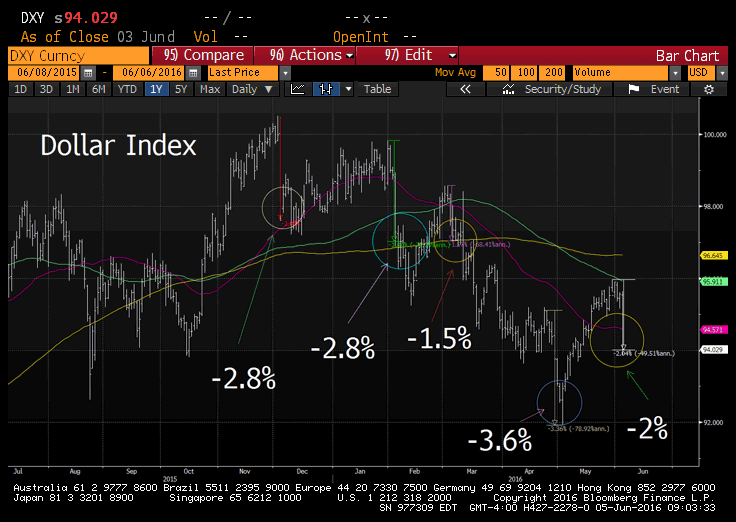Join our Larry McDonald on CNBC’s Trading Nation, Wednesday June 8, at 2pm.
Pick up our latest Bear Traps Report menu here.
Over the last few years, Wall St. banks have lectured us, over and over again on expectations of “strong” jobs reports, oh “how resilient the U.S. economy is.”
“We must be ready for life after liftoff in a rising rate environment.”
Wall St’s Economists
Today, they have their tail between their legs. Even the emperor, Goldman Sachs, who just two months ago was calling for three rate hikes in 2016, has backed away and lowered the bar.
U.S. economy looks to be in danger of losing its main pillar as employers throttled back hiring in May to the lowest level in almost six years. The slowdown — payrolls rose by 38,000 after a downwardly revised 123,000 in April — raised questions about the ability of consumers to keep spending at a good clip. Bloomberg
The U.S. Dollar on Jobs Report Friday
 The U.S. dollar has been acting like a biotech stock in and around incoming jobs data. Central bankers have far too many asset managers trying to create alpha (returns) around their speeches and incoming data. The result? Capital destroying volatility in and around news flow. Each time we see far to many people on once side of the boat, listing her closer to capsizing.
The U.S. dollar has been acting like a biotech stock in and around incoming jobs data. Central bankers have far too many asset managers trying to create alpha (returns) around their speeches and incoming data. The result? Capital destroying volatility in and around news flow. Each time we see far to many people on once side of the boat, listing her closer to capsizing.
Wall St’s Expectations and Crowded Trades

On January 1st, by now the street was expecting 220k to 260k new jobs a month. On Friday, a rough patch in the U.S. economy and a Verizon strike has the crushed the crowd, just 38k jobs were created in May vs Goldman’s 165k above. In recent years, the secret to trading Fed policy and the U.S. economy has been found in measuring just how crowded expectations have become, how much has been priced into each trade.
$13T of Debt = 1m New Jobs
Since 2007, full time jobs in the U.S. have only increased 1m while the population has surged by 23 million people. That’s a lot of former workers (contributors) at the beach. This is NOT “full employment.” That’s a fantasy. BLS data.
Since 2007, U.S. government debts are $10T higher, while corporate debt has advanced by $3T (that’s a doubling). Blind economists are missing the impact of leverage on the economy. Entitlements are clearly crowding out the private sector. BLS data.
Scared Rabbits
The poor street’s terrified economists, after being embarrassed for four of the last 5 months, having their “jobs bar” far too high, now they’re faced with even more uncertainty. We’ve seen this show so many times before, group think is a bad place to be. Huddled together, they feel more secure, but in the end they just make it easier for those willing to take the other side of the trade. There is a reason 99% of economists have never sat in a risk seat, it will stay that way for years to come.
What are they Missing?
For well over the last year, we’ve stressed the global wrecking ball that is the U.S. dollar. Since early 2014, we’ve maintained both a 1.40% target on the U.S. 10 year and zero rate hikes for 2015 and 2016, that’s been our position well stated in our Bear Traps reports. U.S. economists have been far too focused on the U.S. economy instead of the international picture as well as credit risks’ impact on Fed policy and rates.
Get on our next trading ideas and distribution list.
Pick up our latest Bear Traps Report menu here.



Larry and company, your observations on the economy and mkts are so refreshing. For many yrs, I have viewed many mkt participants as lemmings. The ship in danger of capsizing is a good analogy.
While I am my own investment manager, I appreciate your work very, very much. Do you offer investment services? If so what are the details? Minimum initial investment?
Thank you,